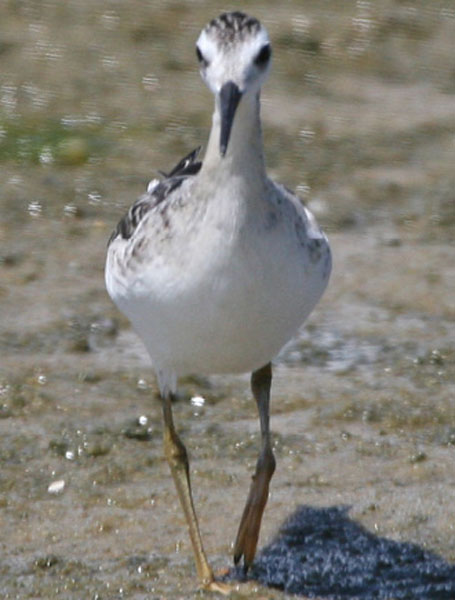Wayne R. Petersen

WAYNE R. PETERSEN
Large-eyed, long-legged, slim-necked, straight-billed, and extensively white below is the impression provided by this issue's mystery species. More than anything, however, it is the bird's long pale legs that offer the best clue to its identity. Although herons and egrets have undeniably long legs, there are enough conflicting features in the photograph that few readers are likely to think in that direction. Indeed, the leg length alone of the mystery bird leaves only a shorebird of some sort as a viable alternative.
With a shorebird in mind, the fact that the bird clearly has light-colored legs is an important clue, a characteristic especially noticeable when viewed in color on the Bird Observer website. This feature is particularly relevant when one considers that most light-legged shorebirds have variously streaked underparts (e.g., yellowlegs, Upland Sandpiper, Pectoral Sandpiper), or else they are buffy below and not strikingly white (e.g., Buff-breasted Sandpiper, juvenile Ruff). There are only two regularly occurring shorebird species in Massachusetts that have strikingly white underparts and light-colored legs: juvenile and nonbreeding plumaged Spotted Sandpipers and Wilson's Phalarope.
Spotted Sandpipers not in breeding plumage always have brownish sides to their upper breast and a white spur-like marking in-between the brownish sides and in front of the bend of the wings. They also have relatively short legs. Clearly the mystery species lacks brownish sides to its upper breast and its legs are decidedly long. When these features are combined with the bird's longish thin neck, prominent white face and eye stripe, and straight thin bill, it can only be a Wilson's Phalarope (Phalaropus tricolor). In breeding plumage an adult Wilson's Phalarope would exhibit dark legs, but from the pictured view it is difficult to determine with certainty if the bird is a juvenile or an adult in nonbreeding plumage.
Wilson's Phalaropes are rare and sporadic breeders in Massachusetts and scarce migrants in both spring and fall, most often appearing from late April to early June, and again in August and September. Though most frequent on the coast, they also occur inland with some regularity. The author photographed this juvenile Wilson's Phalarope at South Beach, Chatham, Massachusetts, on August 10, 2008.
Wayne R. Petersen